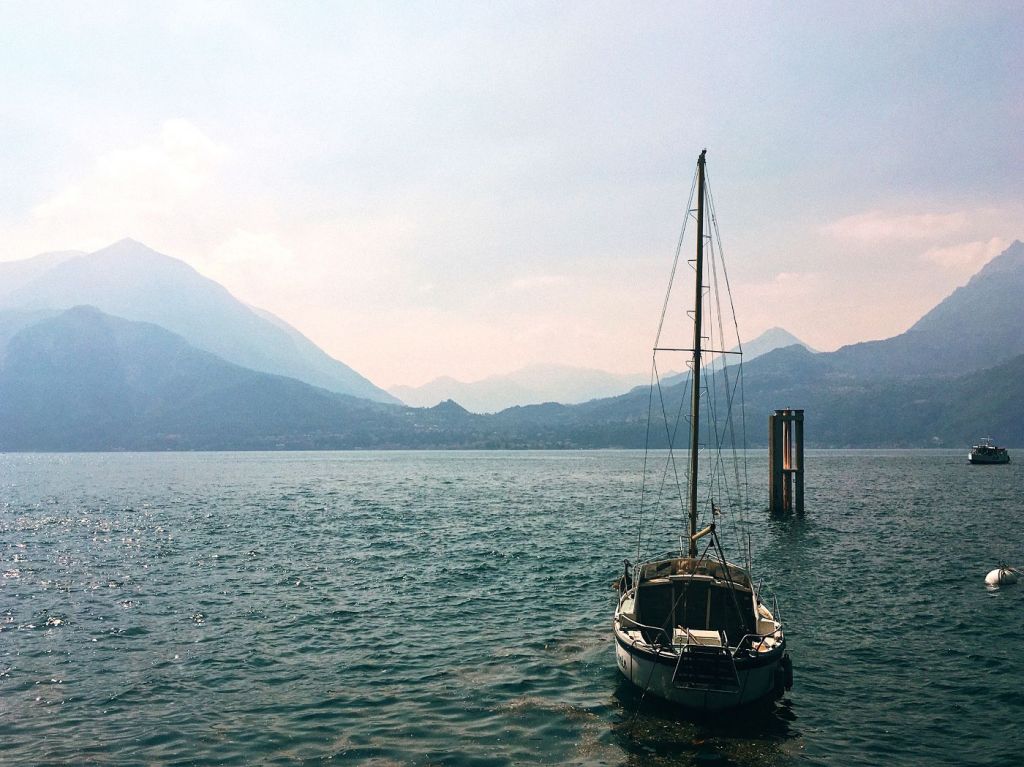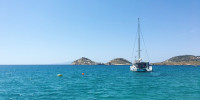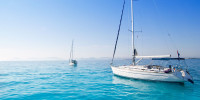How To Anchor a Boat with Two Anchors (Easily & Properly)
Most of the time you anchor, you'll use just one. With other boats around, you shouldn't use two anchors without a compelling reason, because it will make you swing differently from other people. But sometimes you have a challenge in an anchorage, like tidal currents, limited swing space, or other reasons you may need to fix your orientation, eliminate swing, or add extra holding power.
For each of these scenarios, we have the stern anchor, the Bahamian moor, the double anchor, and the V deployment. Your choice of technique depends on the conditions where you anchor and what you might expect, from bad weather to tidal currents and tight swing room.

Staying in One Place (Bahamian Moor)
When staying in one place, you use two anchors to set a Bahamian Moor.
A "Bahamian Moor" is anchoring with two anchors through your bow rollers, with the anchors deployed 180 degrees from each other. This allows your boat to swing with winds and current, but keeps you from swinging around a large circle like you do with a single anchor.
In areas with large tidal currents, concerns that you may pull and reset your anchor through every tide make a Bahamian mooring a popular choice. Tight anchorages are all good applications of this technique, as long as everyone is using it and they set all the anchors in parallel lines.
Setting the Bahamian Moor
The first step is to set the upwind/up current anchor the way you normally would. Set it well, and note the desired scope you want to leave out.
Next, pay out the rode until you've fallen off to the spot to drop the second anchor dead down wind. Drop the anchor, then move the boat back towards the first anchor while paying out the second anchor rode.
When you've brought the first anchor back to the desired scope, you can tie off the second anchor and back down on it to set the second anchor. Snub all lines.
Notes:
- If you're using a rope rode, put a kellet on it if you have one. This will keep the rode from wrapping the keep.
- With a rope rode, you can set the second anchor with a dinghy. This is a useful if the primary rode isn't long enough to reach the drop spot. All-chain rodes are too heavy for dinghy launching.
Weighing Anchor
To retrieve the Bahamian mooring, reverse the process. Ease one rode until you can break out the other anchor and retrieve the other rode. Then retrieve the remaining rode normally.
A kellet is a weight attached to a rode. They are thought to give a better of angle of pull on the anchor, but the additional holding effects are unclear. But kellet will sink the catenary on a rope rode and reduce the chances of it fouling your keel as you swing.
Stopping the Swing (Stern Anchor)
Sometimes, it's important to keep your boat pointed in one direction. You can handle roll in an anchorage with a stern anchor to keep the bow to the waves, and a stern anchor can keep you in place in a narrow anchorage where swinging around may put your boat into a trouble spot.
The major difference between this and a Bahamian moor is that you put an anchor on each end of the boat instead of two anchors on the bow. So there is no swinging at all.
Setting a stern anchor
First, set your primary anchor as you normally would.
Once the first anchor is set, ease out more rode until you drift back to where you want to set the stern anchor. Note that you may not drift back in the direction you need to go. You might need to do some clever tricks with our engine, or even use the dinghy to push the stern around to the right spot.
If your stern anchor and rode is manageable, you can use the dinghy to drop the stern anchor instead.
Once the stern anchor is down, pull the primary rode back to the desired scope, then pull the stern anchor taught and tie it off. Engage the engine in forward to set the stern anchor.
If you have a kellet for the stern anchor, it's not bad to use it.
Weighing Anchor
Your stern anchor is will be a manual retrieval unless you have a stern windlass. The easiest way is to ease the primary rode and drift back on the stern anchor as you pull in its rode. A trip line on this anchor may make it easier to break out, or you can break it from the dinghy if it won't come out.
Getting Extra Holding (Double anchor and V Deployment)
Two double anchor techniques can give you increased holding if you're expecting bad weather or high winds. If a bottom is bad holding like soft mud, a second anchor can help you stay put. We used a double anchor setup to ride out a hurricane at anchor, since it gives you extra holding without the risk of tangling a second rode.
Double Anchor Setup
Tandem anchoring is two anchors on one rode in series - one at the bitter end, and one about a boat length up the chain. The work is setting up the equipment more than setting the anchors, though wrestling two anchors on and off the foredeck without scratching the deck takes some care.
The bitter end
The bitter end is the ship end of the anchor cable, secured by the anchor bitts and the bitter pin in the cable locker under the forecastle.
Source: Wikipedia
Connect the backup anchor to the bitter end of the chain; the best anchor should be closest to the boat. Set the primary anchor a boat length from the end. If you have an extra length of chain, you can attach the secondary anchor with this instead of re-arranging the primary anchor.
When you are rigging your tandem, make sure you run all the rode around and over the life lines! If you just pull the bitter end through the bow roller, you won't be able to get the anchor back through the pulpit! (Don't ask me how I may know this...)
To set the tandem anchors, put the first anchor in the water and lower until it hits bottom. Then splash the second while drifting back from the first anchor. From there, back down, set scope and snub as you would for a single anchor.
Weighing the Tandem
Retrieve this like a single anchor until you get to the first anchor. Secure that anchor on the deck. Take it off the rode to use the windlass to retrieve the second anchor.
V Deployment
Deploying two anchors in a V shape off the bow offers excellent extra holding power when the pull is from an expected direction. Anchoring in a river with a strong, constant current, or for a storm before a big blow from a known direction, are good times to use the V.
To set up a V deployment, set your first anchor the way you would normally. For the second anchor, you're aiming for an angle between the rodes of 45° to 90°. If they're too close together, you risk tangling the anchors. You don't want them in a line or close to it. But if the angle is too large, you lose all the benefits of extra holding against the forces on the boat.
To set the second anchor, motor back up and over to the drop spot. It should be on a line with the first anchor perpendicular to the expected wind or current. Drop the second anchor, then drop back and set it. Then drop all the way back until both anchors are taking some of the boat's weight.
Adjust the lines to distribute the load as equally between the anchors as you can. If conditions change, check the rodes and adjust to keep the loads even.
Weighing the V
Motor up to one anchor and retrieve it, then retrieve the second anchor. You may need to ease a little on the second anchor rode to get to the first one.
What Not to Do
There are two big mistakes you can make when using more than one anchor. Either can leave you worse off than only having one anchor.
Mistake #1: Two anchors in line in front of the boat. Adding a second anchor right near the firsts like it would give you more holding, but you're more likely to end up with a tangled mass of anchors and chains which can't hold at all as the anchors and chains can keep either anchor from setting or lying properly. Even if you manage a clean set with both anchors, even a minor wind shift will kick off a death spiral of tangling and dragging.
Mistake #2: Being the only boat in the anchorage with two anchors. You'll be safe, but in the best-case scenario, you will only annoy everyone around you. In the worst case, because you don't swing like anyone else, you'll get banged around as other boats swing into you and foul your anchor.
Did you find the answer to your specific question?
👍 2 👎 1



Leave a comment